Known as the land of victory, Vizianagaram is home to rich tales of history and elegant architecture. A trip to this region, leaves one enamoured, of the place of prominence it once enjoyed. From the three lantern junction to the clock tower and the pedda cheruvu, there’s much to delight the history buffs in Vizianagaram. Here is a list of the places you must visit in Vizianagaram.
10 places you must visit in Vizianagaram
Vizianagaram Fort
Over three centuries old, the regal Vizianagaram Fort was built in 1713 AD, when Maharaja Vijayarama Raju-I laid the foundation. Made from limestone and bricks, it showcases aspects of Gothic architecture and traditional vaastu principles. The East Gate marks the main entrance, and the Nagaara khana (room of drums) is atop this gate. The West Gate is built in Rajasthani and Kakatiya style and has a viewing pavilion on top. The last crowned king of Vizianagaram, Dr. Pusapati Vijayarama Gajapathi Raju (Dr. P.V.G. Raju), donated his entire property, including many royal mansions for the cause of education.
Highlight: The fort was converted into an educational institution, and is being used as such even today.
Sri Mannar Rajagopala Swamy Temple
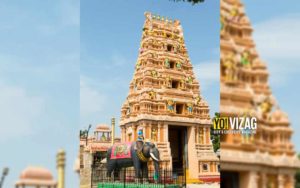 Believed to be over 800 years old, this is locally referred to as the Santhaana Gopala Swamy, Kotha Kovela, or Venugopala Swamy Temple. It is said to have been built under the guidance of Sri Bhagavath Ramanujacharya (1017-1137AD). The annual Kalyanotsavam of the presiding deity here is a five-day festival. This is also the only temple in the region where rituals are performed under Pancha Raatra Agama, a Vaishnava tradition.
Believed to be over 800 years old, this is locally referred to as the Santhaana Gopala Swamy, Kotha Kovela, or Venugopala Swamy Temple. It is said to have been built under the guidance of Sri Bhagavath Ramanujacharya (1017-1137AD). The annual Kalyanotsavam of the presiding deity here is a five-day festival. This is also the only temple in the region where rituals are performed under Pancha Raatra Agama, a Vaishnava tradition.
Highlight: This temple is very popular amongst those seeking to get their wishes fulfilled.
Maharaja Sanskrit College
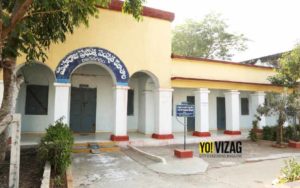
Preserving Shastras and Vedas since 200 years now, this is the only Government oriental college for the States of Andhra and Telangana. Established in 1860 across one and half acres, by the Gajapathi rulers, it saw many stalwarts be a part of both teaching and learning communities. In 1957, the Government took up operations and the college was renamed as the Maharajah Government Sanskrit College. Its first principal was Dr. Sarvasri Ramanujachari.
Highlight: It is unique and perhaps the only of its kind in the region, which makes it one of the places that one must visit in Vizianagaram.
Pydithalli Ammavari Temple
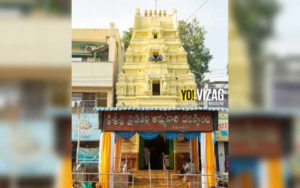 Worshipped as the presiding deity or ‘grama-devata’ of Vizianagaram, the Goddess is believed to have been the king’s sister. Legend has it that when the king was slain in battle, his sister fainted and then subsequently died. Before dying, she told her assistant to build a temple for her, at the place where her idol would be found. Accordingly, the idol was found on the first Tuesday after Vijayadasami on the western tank bund of Pedda Cheruvu and a temple was constructed on the same site. Since then, for the last 250 years, on the first Tuesday after Vijayadasami (Dussehra), the temple festival of Sirimanu Utsavam is celebrated.
Worshipped as the presiding deity or ‘grama-devata’ of Vizianagaram, the Goddess is believed to have been the king’s sister. Legend has it that when the king was slain in battle, his sister fainted and then subsequently died. Before dying, she told her assistant to build a temple for her, at the place where her idol would be found. Accordingly, the idol was found on the first Tuesday after Vijayadasami on the western tank bund of Pedda Cheruvu and a temple was constructed on the same site. Since then, for the last 250 years, on the first Tuesday after Vijayadasami (Dussehra), the temple festival of Sirimanu Utsavam is celebrated.
Highlight: The grandly celebrated Sirimanu Utsavam, sees the priest taking procession between the fort and the temple, seated at the edge of a 60feet stick raised high in the sky.
Sri Vasavi Kanyaka Parameswari Temple
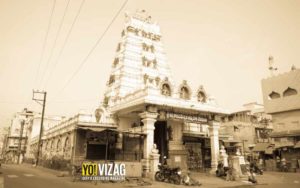 As per legend, a local chieftain of the Vysya Community, Kusuma Sresti had a beautiful daughter named Vasavi. A visiting Emperor, Vishnu Vardhna, was smitten by her beauty, but the idealistic princess rejected his advances. Enraged, he declared war and tried to take her by force. The prospect of sacrificing soldiers to protect her honour troubled the princess, who chose to sacrifice herself in a pyre. Believing her to be an incarnation of the Goddess, the Vysya Community worships and follows her ideals of leading a life of non-violence. A temple dedicated to the young Goddess was constructed by the local Vysya traders in 1890 on land provided by the Vizianagaram King.
As per legend, a local chieftain of the Vysya Community, Kusuma Sresti had a beautiful daughter named Vasavi. A visiting Emperor, Vishnu Vardhna, was smitten by her beauty, but the idealistic princess rejected his advances. Enraged, he declared war and tried to take her by force. The prospect of sacrificing soldiers to protect her honour troubled the princess, who chose to sacrifice herself in a pyre. Believing her to be an incarnation of the Goddess, the Vysya Community worships and follows her ideals of leading a life of non-violence. A temple dedicated to the young Goddess was constructed by the local Vysya traders in 1890 on land provided by the Vizianagaram King.
Highlight: Kanyaka Parameswari is revered as the ‘Kula Devatha’ of the Vysya community.
St. Mary’s Church
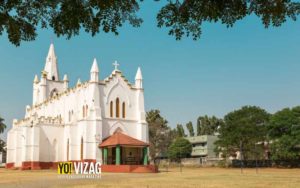 Built by the Dutch during the early part of the eighteenth century, this construction was consecrated in 1852. The centre stained glass of the altar depicting Jesus Christ was stolen in 1952. Till date it showcases an empty cross, marking the space from where it was stolen.
Built by the Dutch during the early part of the eighteenth century, this construction was consecrated in 1852. The centre stained glass of the altar depicting Jesus Christ was stolen in 1952. Till date it showcases an empty cross, marking the space from where it was stolen.
Highlight: The beautiful structure showcases the rich construction of the past, and is a window into the ancient styles used.
Bobbili
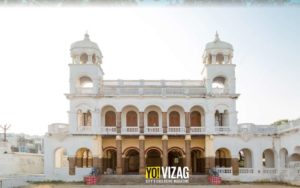 Bobbili holds many attractions, and the palatial Bobbili Fort spread over 10 acres is one of them. It is known to have been built from the 1850s to 1870s, after the original mud-fort was totally demolished in the historic Battle of Bobbili (1757). A commemorative pillar erected in the ruins serves as a reminder of their gallantry. Revered since the founding of the Bobbili Kingdom, the Venugopala Swami Temple was also reconstructed using the ancient idol recovered from the ruins. The region is home of the famed ‘Bobbili Veena’ since the seventeenth century. Today miniature veenas made to scale are greatly popular, as gifting options. Finally, a trip here is incomplete without visiting the looms, where the soft cotton Bobbili saris are woven.
Bobbili holds many attractions, and the palatial Bobbili Fort spread over 10 acres is one of them. It is known to have been built from the 1850s to 1870s, after the original mud-fort was totally demolished in the historic Battle of Bobbili (1757). A commemorative pillar erected in the ruins serves as a reminder of their gallantry. Revered since the founding of the Bobbili Kingdom, the Venugopala Swami Temple was also reconstructed using the ancient idol recovered from the ruins. The region is home of the famed ‘Bobbili Veena’ since the seventeenth century. Today miniature veenas made to scale are greatly popular, as gifting options. Finally, a trip here is incomplete without visiting the looms, where the soft cotton Bobbili saris are woven.
Highlight: The uniqueness of the Bobbili veena, has given the town its own Geographical Indication (GI) tag.
Kumili
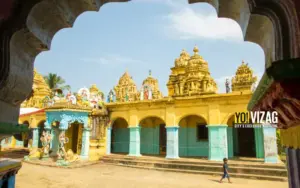 Situated about 20 km from Vizianagaram, this small village is famous for a collection of beautiful temples all clustered in a complex. Each temple is adorned with intricately carved sculptures, idols and paintings on the walls. With intricate woodwork on the doors, the story of Ramayana is also painted on the walls. As the former seat of the erstwhile Vizianagaram Kingdom, ruins of a mud fort still exist here. The complex comprises of temples dedicated to Kalika Devi, Satyanarayana Swamy, Navagrahas and Lord Ganapathi. Temples of Anjaneya Swamy, Lord Subramanyeswara, Lord Venu Gopalaswamy and Seetharamaswamy are present as well.
Situated about 20 km from Vizianagaram, this small village is famous for a collection of beautiful temples all clustered in a complex. Each temple is adorned with intricately carved sculptures, idols and paintings on the walls. With intricate woodwork on the doors, the story of Ramayana is also painted on the walls. As the former seat of the erstwhile Vizianagaram Kingdom, ruins of a mud fort still exist here. The complex comprises of temples dedicated to Kalika Devi, Satyanarayana Swamy, Navagrahas and Lord Ganapathi. Temples of Anjaneya Swamy, Lord Subramanyeswara, Lord Venu Gopalaswamy and Seetharamaswamy are present as well.
Highlight: The temples were known to have been by Sri Animisha Bhagavan, a local devotee, between 1933-1966.
Ramatheertam
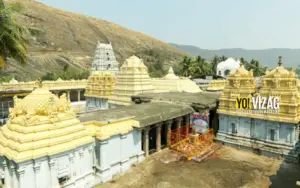 Located on a hill, nearly 13 km away from Vizianagaram this temple is believed to be one thousand years old. The temple was established during the sixteenth century under the reign of Pusapati kings. Situated in the proximity of the temple is a lake called Koneru. On the southern-most hill is the Rama Temple, while the northern hill known as Durga Konda, has a natural cave in which there is an idol of Goddess Durga.
Located on a hill, nearly 13 km away from Vizianagaram this temple is believed to be one thousand years old. The temple was established during the sixteenth century under the reign of Pusapati kings. Situated in the proximity of the temple is a lake called Koneru. On the southern-most hill is the Rama Temple, while the northern hill known as Durga Konda, has a natural cave in which there is an idol of Goddess Durga.
Highlight: The entire temple is believed to have been built entirely on one huge rock.
Ramanarayanam
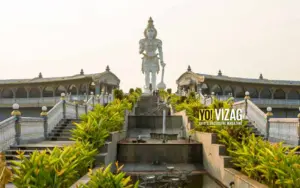 Another one of the places in Vizianagaram that one must visit is Ramanarayanam. A comparatively recent addition, Ramanarayanam is a religiously themed complex depicting scenes of the great epic of Ramayana. The centrally air-conditioned edifice houses the sculptures in a unique bow and arrow-shaped construction. A Lord Vigneswara Temple is at the entrance and at the tip of the arrow, a 60-feet-high Hanuman statue has been installed which is visible even from a distance of 1 km. Spread across 20 acres, the park’s verdant greenery includes nine sacred trees. In addition, there are temples dedicated to Lord Rama and Vishnu, a huge library with spiritual books, meditation centre, residential Veda Pathshala, and a boutique vegetarian restaurant.
Another one of the places in Vizianagaram that one must visit is Ramanarayanam. A comparatively recent addition, Ramanarayanam is a religiously themed complex depicting scenes of the great epic of Ramayana. The centrally air-conditioned edifice houses the sculptures in a unique bow and arrow-shaped construction. A Lord Vigneswara Temple is at the entrance and at the tip of the arrow, a 60-feet-high Hanuman statue has been installed which is visible even from a distance of 1 km. Spread across 20 acres, the park’s verdant greenery includes nine sacred trees. In addition, there are temples dedicated to Lord Rama and Vishnu, a huge library with spiritual books, meditation centre, residential Veda Pathshala, and a boutique vegetarian restaurant.
Highlight: In the evenings, the entire area is colourfully lit up and cultural programmes are often organised in a huge hall (Kalyana mandapam).


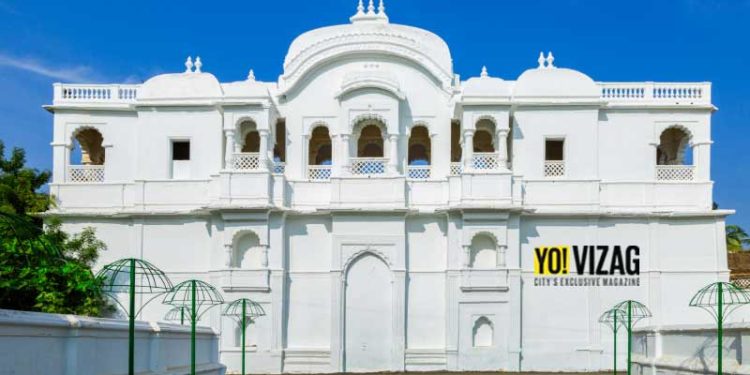







Discussion about this post